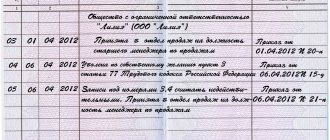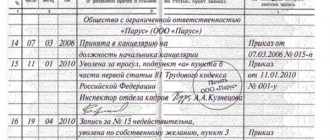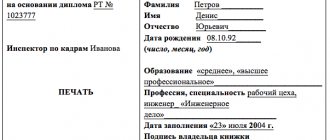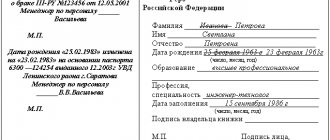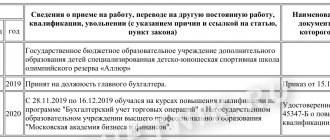Familiarization of the employee with the entries in the work book
Update: December 16, 2020
Organizations and individual entrepreneurs keep work books for their employees. This document confirms the fact of the employee’s labor activity and his length of service. As a result, the information entered in this document influences the employee’s subsequent employment and the calculation of a pension upon completion of his working career. For this reason, the legislation strictly regulates the procedure for maintaining this document, giving clear recommendations on making certain entries and performing other actions with this document (production of forms, storage, etc.). The employee must be familiarized with the entries in the work book (a sample record of such familiarization is not provided for by law; the employee’s signature is sufficient for appropriate confirmation).
Employment history
The work book is a small multi-page document consisting of several sections. Its form is provided by the state and is mandatory for use based on the provisions of the law. The work book contains the history of work activity and the length of service of the employee.
The form and procedure for compiling such books are enshrined in two by-laws:
- Rules approved by Decree of the Government of the Russian Federation of April 16, 2003 N 225 (hereinafter referred to as the Rules);
- Instructions approved by Resolution of the Ministry of Labor of the Russian Federation dated October 10, 2003 N 69 (hereinafter referred to as the Instructions).
The document in question is usually kept by the employer. An exception to the rules is when the employee is not employed by an organization or an individual entrepreneur.
The legislation provides for cases when an employee has access to this document to put his signature on it for familiarization.
Clause 12 of the Rules obliges employers to familiarize employees with the following information recorded in the work book:
- information about the work performed;
- information about transfers;
- records of dismissals and their reasons.
As a rule, familiarization is carried out as follows:
- the official of the personnel department writes down the relevant information in the work book and personal card, after which he invites the employee to familiarize himself with it;
- after the employee familiarizes himself with the entry, the specified official asks him to sign the entry in the work book and personal card.
The form of the personal card is contained in the Appendix to the Resolution of the State Statistics Committee of Russia dated January 5, 2004 N 1 (unified form No. T-2).
In order to confirm the fact of familiarization, the employee only needs to sign.
It is important to determine when exactly it is necessary to familiarize the employee with the relevant information.
Clause 35 of the Rules states that upon dismissal, entries in the employee’s work book are confirmed by the employer and the employee, except in the case where the work book is not handed to the employee, but by mail (with his consent).
Thus, to familiarize an employee with the entries in the work book, it is enough to sign his signature once upon dismissal.
You should not indicate any additional wording in the work book (for example, “acquainted,” “I confirm the information,” “the entry is correct,” and the like).
The information contained in employee work books is of great importance not only during their active professional activity, but also upon retirement. Any inaccuracy can have negative consequences for working citizens, for example, significantly reduce their actual length of service. It is no coincidence that familiarization of the employee with the entries in the work book is the responsibility of any employer, but only in strictly defined cases.
Hiring and dismissing a director: personnel records
The employment relationship with the employee ends with the issuance of a dismissal order and the entry of this into the work book. The dismissal record itself is quite simple to make, because the Instructions for filling out work books 1 (hereinafter referred to as the Instructions) contain sample wording regarding almost all the most common grounds for termination (termination) of an employment contract.
So, the dismissal record has been made. Now the employee responsible for maintaining work books must “close” and certify all entries made in the work book by this employer. How to do it?
The answer to this question can be found in the Rules for maintaining and storing work books, producing work book forms and providing them to employers2 (hereinafter referred to as the Rules). According to clause 10 of the Rules, upon dismissal of an employee (termination of an employment contract), all entries made in his work book during his work in this organization are certified by the signature of the employer or the person responsible for maintaining work books, the seal of the organization (personnel service) and the signature of the employee himself .
At first glance, this norm contains extremely clear instructions. Despite this, in practice specialists encounter some difficulties. First of all, the question arises: which of the organization’s officials should sign for the employer in this case? According to clause
45 of the Rules, the employer bears responsibility for working with the work book (maintenance, storage, accounting, issuance, etc.). But the employer for the employee is a legal entity or an individual entrepreneur (other employers - individuals do not keep work books for their employees).
With an individual entrepreneur, everything is clear - he himself can make entries in the work book. What if the employer is a legal entity? In this case, the manager (that is, the sole executive body) is responsible for everything.
He may be called a director, general manager, or even president. This does not change the essence - full responsibility lies with him as a representative of the employer. This means that the manager himself can certify the records upon dismissal.
However, it is rare that a manager personally deals with work books (maybe with the exception of managers of small businesses). Most often, responsibility for maintaining, storing, recording and issuing work books rests with a specially authorized person appointed by order (instruction) of the employer.
This could be a personnel officer, an accountant or a secretary who has been assigned additional responsibilities for maintaining work books as part of personnel records management. Please note that simply mentioning these responsibilities in an employment contract or job description is not enough.
Example 1
An individual entrepreneur can also appoint any of his employees responsible for working with work books, as most often happens in practice.
Sometimes it happens that the employee appointed responsible for this work (in our example, this is the secretary) goes on sick leave, and therefore cannot issue a work book for the resigning employee.
What to do in this case? It is best if the manager independently issues a work book for the employee. If the manager for some reason does not want or cannot do this, then he should issue an order with the following content (see Example 2).
Example 2
Thus, the block of entries in the work book must be closed with the signature of a specially authorized person. If you are such a person, then you may have a number of other questions regarding the method of registration.
2 of the Rules for maintaining and storing work books, producing forms and providing them to employers (approved by Government Decree No. 225 of April 16, 2003) of the established form is the main document on the employee’s activities and work experience.
The employer (with the exception of employers - individuals who are not individual entrepreneurs) maintains work books for each employee who has worked for him for more than five days, in the case where work for this employer is the main one for the employee.
The procedure for issuing a work permit to a dismissed employee involves the implementation of several sequential procedures, the most labor-intensive and responsible of which is preliminary preparation for issuance, which in general must be completed by the date of his dismissal.
Read more about this in the presented material. The dismissal of an employee (termination of an employment contract) is accompanied by the issuance of an order, instruction or other decision of the employer and the making of a corresponding entry in the document.
In this case, when registering a book, you should be guided by section 5
“Filling out information about dismissal (termination of employment contract)”
Instructions for filling out work books, approved by the Decree of the Ministry of Labor of the Russian Federation of October 10, 2003.
Entries in the work book about the reasons for termination of the employment contract must be made in strict accordance with the wording specified in the order (instruction) on termination of the employment contract, and with reference to the relevant article of the Labor Code of the Russian Federation or other federal law.
Then, together with the employee, you need to check whether the records of hiring, transfers, assignment of qualifications, incentives (awards) and dismissal are entered correctly. If an error is discovered, appropriate corrections must be made.
After which, in accordance with clause 35 of the Rules for maintaining work books, all entries made in his work book during his work at this enterprise, including in the section “Information on awards (incentives)”, are certified by the signature of the employer or the person responsible for maintaining work books, the seal of the enterprise or personnel service, as well as the signature of the employee himself (Fig. 27).
Fig. 27 Sample of a work book when dismissing an employee
If the resigning employee refuses to put his signature in the work book, it must be explained to him that, according to clause 35 of the Regulations on maintaining work books, he is obliged to put his signature in the work book after familiarizing himself with the records available there.
Fig. 28 Sample act of refusal to sign in the work book
When filling out a work book in the state language of the Russian Federation and in the state language of the republic within the Russian Federation, both texts are certified.
The work book is issued to the employee on the day of dismissal (last day of work) with an entry about dismissal (termination of the employment contract) included in it.
We had a dispute with lawyers. Please tell me, when dismissing the general director, who should sign the notice of dismissal in the work book? We (the HR department) believe that the director himself can sign, because
on the day of dismissal, he is still a director, and lawyers believe that the founder who signed the employment contract for the Company should sign. Who is right? Thanks for the answer. Answer According to paragraph 35 of the Decree of the Government of the Russian Federation of April 16, 2003.
No. 225 “On work books”, upon dismissal of an employee (termination of an employment contract), all entries made in his work book during his time working for a given employer are certified by the signature of the employer or the person responsible for maintaining work books, the seal of the employer and the signature of the employee himself. B Art.
It's fast and free! Table of contents:
- Grounds for termination of the contract
- How is a mark entered into the book?
- Who makes the entry and who signs?
- date of dismissal
- Design features and possible errors
- Conclusion
Grounds for termination of the contract Possible reasons for dismissal may include the following:
- own wish;
- the founders’ decision not to renew the employment agreement upon expiration of the contract;
- early termination of the contract in connection with the liquidation of an LLC or JSC.
We suggest you familiarize yourself with: Dismissal by transfer to another position, to another employer or company.
An entry in the work book is always written on the basis of some document, most often an order. In case of dismissal from office, the boss himself issues an order for personal dismissal in the T-8 form. Important! In accordance with Art.
The Labor Code of the Russian Federation stipulates that the rights and obligations of the employer in labor relations are exercised by the management bodies of a legal entity (organization) or persons authorized by them. In accordance with part 2 of Art.
69 of the Federal Law of December 26, 1995 No. 208-FZ “On Joint Stock Companies”, the general director is the sole executive body of the company and, without a power of attorney, acts on behalf of the company, including representing its interests, making transactions on behalf of the company, approving staff, publishing orders and gives instructions that are binding on all employees of the company. Similar provisions are also enshrined in Part 3 of Art. 40 Federal Law of February 8, 1998
But for this, the fact of dismissal must be recorded in the applicant’s labor code with an appropriate entry. Without it, recruitment to a position cannot take place. The next stage will depend on who the director’s employer is:
- municipality;
- himself;
- co-founders.
In addition, it will be important whether the position is elected or whether the person is appointed by order of higher-level management. Depending on these factors, the algorithm for further actions should work, which may include:
- In simple acceptance by order.
- In a similar edition of the order to himself.
- In the resolution of the co-founders.
After establishing the basis, an order for employment is issued and an entry is made into the labor record.
- Local acts and regulations.
- Decision of the constituent assembly.
- Basic rules for making an entry Under the form of ownership: LLC, CJSC, etc., the director is elected by the general meeting. The presiding officer approves the protocol, which becomes a statement of the fact of the appointment. An employment contract must be drawn up according to general rules, in a generally accepted form. But instead of the employer, the party employing the director is the chairman of the meeting of founders. He also has the right to sign an order, which is based on the result of the decision of the founders, and the right to sign an order for the director to take office. As in other cases, the name of the organization in the work book must be entered in the entry.
After all, this is the only document demonstrating the actual reason for leaving work, and the next employer will be able to analyze the employee’s work activity. Example: Dismissed due to a decision by the general meeting of owners to terminate the employment contract, in accordance with paragraphs.
- serial number of the record;
- dates;
- appointment order.
- put a new serial number;
- enter information regarding the previous entry being considered invalid;
- put the next serial number;
- re-enter information about care;
- put signatures where they need to go.
- the title of the position of the person who signed the document;
- personal signature of the above person;
- Full name as a transcript of the painting.
Dear readers! Our articles talk about typical ways to resolve legal issues, but each case is unique. If you want to find out how to solve your particular problem, please use the online consultant form on the right or call. It's fast and free! Table of contents:
- How to correctly fill out a work report when dismissing an employee?
- Signature on document
- What to do if it is in the wrong place?
- No signature
- Conclusion
What the Rules Say
The fact that the work book (hereinafter referred to as the Labor Book) is the main document of the employee is stated in Article 66 of the Labor Code. Not only organizational employers, but also individual entrepreneurs are required to maintain it, provided that the owner of the document has worked for more than five days.
Employee work books are prepared and stored in accordance with two main documents:
- Rules for maintaining and storing TC (Government Decree No. 225 of April 16, 2003);
- Instructions for filling out the Labor Code (Resolution of the Ministry of Labor No. 69 of October 10, 2003).
In particular, paragraph 12 of the above Rules established in which cases it is mandatory for an employee to familiarize himself with the entries in the work book. There are only three of them:
- when you need to make a record in the Labor Code about the work being performed;
- when an employee is transferred to another job;
- when he gets fired.
In the listed situations, appropriate entries are made in the work books, which the employee must be familiarized with upon receipt. According to this paragraph of the Rules, he puts it on his personal card. Before this, the personnel officer duplicates the entry that was made in the employee’s Labor Code.
Nuances of familiarizing yourself with records in the Labor Code
However, there is one more requirement in the Rules for Maintaining and Storing Work Records. Point 35 states that upon dismissal, an employee certifies with his signature all entries made in the document during his time working in this company. And he puts it directly in the shopping center. It follows from this that, when resigning, a citizen certifies the entries not only in the personal card, but also in the work book. But while he is working in the company, he only signs on his card to familiarize himself with the entries made in the Labor Code.
There is no special form of assurance that the employee is familiar with the entries in the work book. No normative act provides for a sample, and experts advise: familiarization with the information entered in the book is sufficient to confirm only with the signature of the employee. You should not add to it the phrases “the information is correct”, “I certify the record” or other wording of similar content.
Briefly about the main thing
Termination of the employment relationship for one reason or another is first formalized by a dismissal order. This is followed by a procedure for recording in the employment document, recording the date of dismissal, order number, and reason for dismissal.
We will not dwell in detail on the wording of this entry , since the modern version of the “Instructions for filling out work books” is available and includes all the wording for the most common reasons for the dismissal of an employee.
Let's start from the moment when the entry has already been made. The next stage will be its official certification. How exactly this aspect is implemented is suggested by a special regulatory document called “Rules for maintaining, storing work books, producing forms for them, as well as providing them to employers” (hereinafter referred to as the Rules).
In particular, clause 10 of this set of Rules stipulates that during the cancellation of an employment contract with an employee, all entries that were made during the labor process in his work book (hereinafter used in the text as Labor Code) must be endorsed by the employer’s personal signature or the person responsible for working with the Labor Code, signature of the dismissed employee, as well as the seal of the institution.
Below we will consider in more detail each point of the entire procedure and who signs it. But before you start, I would like to make sure that you know what an entry in the work book looks like when a position is reduced, what to write when resigning of your own free will. Otherwise, you simply won’t understand what we’re talking about.
Procedure: example
What actions will be required from a personnel officer who wants to familiarize an employee with an entry in a work book can be seen in the following example. The employer transfers the employee to another position. In this case:
- An appropriate transfer order is issued, which the employee signs after review.
- A record of the transfer is made in the Labor Code and is shown to the employee.
- The entry is duplicated in the employee’s personal card, and there he confirms with his signature that he knows its contents.
How to properly certify a record
The rules stipulate that the employee signs after the entry is made.
Traditional design scheme:
- The HR specialist indicates his position.
- signs.
- does the decoding. For example, he writes: Ivanov A.L.
There is one important point here.
The rules prohibit abbreviations on the form. It turns out that putting initials instead of the full name and patronymic is incorrect. Therefore, there is a second assurance option. Sample: Ivanov Alexey Leonidovich. Another question arises: to indicate the position of a specialist or not. When the official receives the document on the last working day, the position is indicated. If a person has already quit and takes the form, then the position is not written.
Writing the words “I assure” and “I have become familiar” also makes no sense. The law does not establish an obligation to write additional words for those who sign the work book upon dismissal.
Important! The specialist must sign not only the book, but also the personal card. Personal cards must be kept in paper form; registration using a computer is not allowed.
So, there are several options for how to fill out the documents. You just need to choose the appropriate option and follow the requirements of the Rules and Instructions for filling out the books.
In progress
According to Decree of the Government of the Russian Federation dated April 16, 2003 N 225, the employer is obliged to familiarize the employee with the entered information.
Information about each new entry made in the employee’s work book must be recorded in his personal card. The employee must sign it as a sign of familiarization with the information.
It happens that the structural divisions of an organization are located in different cities. Then the relevant information and information is provided in absentia, a notice is sent to the employee, followed by a note about this in the personal card.
Upon dismissal
In accordance with paragraph 35 of the “Rules for maintaining and storing books...”, upon dismissal, all information that was entered in this organization into the employee’s work record must be certified by the signature of the employer (or a person authorized by him), the seal of the organization and the signature of the employee himself.
This is in theory. In practice, many questions arise, for example, is it necessary to write “acquainted” in the work book? Formally, it is not needed. The regulations do not require this. But its presence will not be considered an error.
Filling errors
- Only the painting is done.
- The date is indicated.
- The wording “Acquainted” is indicated in other variations.
- A signature is placed indicating the person’s last name without initials.
- Records are certified by the seal of the HR department.
A personal signature without decoding loses its meaning, since it does not allow us to understand who put it. Correct familiarization is when there is a signature of the employee, his last name and initials. When to put the stamp, before or after the person’s signature, is at the discretion of the employer.
How to correctly fill out a work report when dismissing an employee?
The filling rules are based on Instruction No. 225, which provides detailed instructions on the rules for making entries. According to them, it is required:
- enter the serial number of the entry being made.
- Indicate the date: day, month, year when the owner of the book was fired.
- Make a record of the termination of work, indicating the reason and with reference to the relevant article of the Labor Code.
- Indicate the reasons for making the entry (order details).
After filling out the form, certify the entered information with a signature and stamp.
Is it necessary for an employee to sign a work book upon dismissal?
Quote (Natalia Prokhorova): The question is precisely that there is no signature of the employee after the dismissal entry in the labor report. If there is no employee signature in the Labor Code after the dismissal entry, this is also a violation. According to the same Decree of the Government of the Russian Federation of April 16, 2003 N 225, responsibility 45 is provided. Responsibility for organizing the work of maintaining, storing, recording and issuing work books and inserts in them rests with the employer. Responsibility for maintaining, storing, recording and issuing work books lies with a specially authorized person appointed by order (instruction) of the employer. For violation of the procedure for maintaining, recording, storing and issuing work books established by these Rules, officials bear responsibility established by the legislation of the Russian Federation. As for the legislation, these violations are subject to liability under Art. 5.27. Code of Administrative Offences. Article 5.27. Violation of labor legislation and other normative legal acts containing norms of labor law 1. Violation of labor legislation and other normative legal acts containing norms of labor law, unless otherwise provided by parts 2 and 3 of this article and Article 5.27.1 of this Code, shall entail a warning or the imposition of an administrative fine on officials in the amount of one thousand to five thousand rubles; for persons carrying out entrepreneurial activities without forming a legal entity - from one thousand to five thousand rubles; for legal entities - from thirty thousand to fifty thousand rubles. 2. Actual admission to work by a person not authorized to do so by the employer, in the event that the employer or his authorized representative refuses to recognize the relationship that has arisen between the person actually admitted to work and this employer as labor relations (does not conclude with the person actually admitted to work, employment contract) - entails the imposition of an administrative fine on citizens in the amount of three thousand to five thousand rubles; for officials - from ten thousand to twenty thousand rubles. 3. Evasion from registration or improper execution of an employment contract or the conclusion of a civil contract that actually regulates labor relations between an employee and an employer - entails the imposition of an administrative fine on officials in the amount of ten thousand to twenty thousand rubles; for persons carrying out entrepreneurial activities without forming a legal entity - from five thousand to ten thousand rubles; for legal entities - from fifty thousand to one hundred thousand rubles. 4. The commission of an administrative offense provided for in Part 1 of this article by a person who has previously been subjected to administrative punishment for a similar administrative offense shall entail the imposition of an administrative fine on officials in the amount of ten thousand to twenty thousand rubles or disqualification for a period of one to three years. ; for persons carrying out entrepreneurial activities without forming a legal entity - from ten thousand to twenty thousand rubles; for legal entities - from fifty thousand to seventy thousand rubles. 5. The commission of administrative offenses provided for in parts 2 or 3 of this article by a person who has previously been subjected to administrative punishment for a similar administrative offense - entails the imposition of an administrative fine on citizens in the amount of five thousand rubles; for officials - disqualification for a period of one to three years; for persons carrying out entrepreneurial activities without forming a legal entity - from thirty thousand to forty thousand rubles; for legal entities - from one hundred thousand to two hundred thousand rubles.
As a rule, upon dismissal, an employee must sign that he has read the entries in the work book. At this stage, the labor relationship between the organization and the employee ends. When the question arises where an employee should be familiarized with the entry in the work book, one clear answer can be given - in the personnel department of the organization where he worked and where he is leaving.
Resolution of controversial situations
If everything goes well, the employee will have no problem signing his autograph upon dismissal. A completely different situation is when a person leaves with a scandal and refuses to certify the document. The employer needs to protect itself from blackmail and resolve the issue: whether the employee must sign the work book upon dismissal. The guidelines for action are enshrined in Article 193 of the Labor Code. The act must be signed by two, or even better, three employees, preferably not related to the job responsibilities of the dismissed specialist.
The act must be completed or you will have to pay fines. Failure to provide an autograph from a fired employee is a serious violation.
Labor law requirements must be strictly observed to avoid sanctions. The punishment is established by Article 5.27 of the Code of Administrative Offences. The violator pays fines. The manager risks receiving a fine of up to five thousand rubles. The company is subject to a penalty of thirty to fifty thousand rubles. Fines increase if repeated violations are discovered.
Viewing the records
The employee’s turn to sign to review the entries in the work book comes after the employee responsible for storing the books signs.
Very often, workers, not knowing how to do it correctly, make various mistakes. For example, they put only their own signature without decoding or supplement it with just their last name. The lack of initials is a very big drawback.
It is also considered an error to include such wording as “I have read the records.” Typically, an argument in favor of this entry can be a statement that similar wording was found in a manual or article. Some may provide a link to clause 35 of the Rules. But according to this clause, the signature opposite this entry must be put not only by a former employee of the enterprise, but also by its director. Therefore, the entry “acquainted” in the work book in this case should be made according to all the rules.
Explanation upon review
Often, when drawing up a work book, next to the signature of the person responsible for maintaining the book, another unknown signature may appear, which has no decoding at all. The reason for this is the opinion of experts that instead of indicating full “details” you can just subscribe.
In addition, when an employee becomes familiar with the entries in the work book, some employees write down the transcript too illegibly. This can also cause problems. This is especially true for those who come from another country, where the writing and style are too different from the Cyrillic alphabet. Therefore, it is necessary not only to make a complete transcript, but also to write it down carefully and legibly.
Some people believe that when closing a block of all records, the employee does not have to provide a transcript and only his signature will be enough. This is a mistake, therefore, after the employee has read the entry in the work book, he must write his full name and initials. And this mistake is widespread for one simple reason: many people think that one decryption at the very beginning of the work book is enough. This argument is wrong. For example, the owner of the book is a woman, and after she gets married, her last name will change and the entry will be different.
Work books. Certification of dismissal records.
An example of a similar design of the signature of a dismissed employee and the signature of the person responsible for maintaining work records
Option 1 (4.7.5) (the employee worked as a freight forwarder)
When the job title is too long, it is often proposed to replace it with the word “employee”.
Option 2 (4.7.6)
This position is justified as follows. According to clause 3.22 of GOST R 6.30-2003 “Unified documentation systems. Unified system of organizational and administrative documentation. Requirements for the preparation of documents” the “signature” requisite includes:
— name of the position of the person who signed the document;
— personal signature;
— decoding of the signature (initials, surname).
Of course, the Rules and Instructions do not directly indicate the need to be guided by GOST when working with a work book, and the work book itself, strictly speaking, does not relate to organizational and administrative documentation. However, it is quite acceptable to focus on the specified standard, since this does not contradict the general procedure for maintaining and filling out work books and is consistent with established practice.
The signature of the person responsible for maintaining work records, which is made under the dismissal record, traditionally complies with the requirements of GOST and is carried out according to the scheme: “Position. Signature. Full name". It is logical that the signature of the person responsible for maintaining work records and the signature of the employee should be made according to the same rules, because clause 35 of the Rules does not differentiate between them.
At the same time, there is one caveat.
Sometimes an argument is made against indicating the position in the employee’s signature in the work book, namely, some experts argue that the resigning employee is no longer an employee and he no longer has any position. Let us remember that the day of dismissal is usually the last working day, and the employee still holds his position. It’s another matter when an employee receives his book not on time, but after dismissal. Then the position can no longer be indicated. And the word “employee” would not be appropriate.
Regarding some additional words in the employee’s signature, we note the following: almost all experts believe that there is no need to write the words “agree” or “acquainted”. Neither the Labor Code of the Russian Federation, nor the Rules, nor the Instructions require this. However, sometimes there is an opinion that the word “I certify” can be written before the signatures, since paragraph 35 of the Rules talks about certifying with signatures the entries made in his work book. We think all these extra words are unnecessary. The employee's signature is sufficient.
Thus, in practice, there are various options for registering signatures on a notice of dismissal. This is due to the ambiguity of the current legislation.
Indication of the employee's position
Also, it is not entirely according to the rules that a record will be made without indicating the position from which the employee was dismissed. The main argument in this case is that the former employee is no longer an employee of this enterprise, therefore, when he writes that he has read the entries in the work book, indicating in what position he was employed is not necessary at all.
In fact, this argument directly contradicts labor laws. After all, according to the Labor Code of the Russian Federation, on the day of dismissal of an employee, he is still considered an employee of the enterprise. And in the timesheet, which indicates working hours, this day is considered worked. Thus, according to the above arguments, it is necessary, in addition to the signature and its transcript, to indicate the position of the person leaving.
The problem arises in the event of dismissal, for example, of an engineer whose job title includes a list of all the processes in which he is involved. That is, it can take up a lot of space in the work book. The question also arises of what to do if a person leaves the HR department, and his job title is the same as that of the employee firing him. How then to make an entry in the work book about familiarization? In this case, it is recommended to simply put the word “employee” followed by a signature.
The signatures of the former employee and the personnel officer are in one column, one below the other, and without missing lines at all. Immediately after the HR specialist signs, you need to put a stamp. But in practice, things happen differently: the seal is placed after the signature of the person being fired, so that the stamp is placed optimally.
Related posts:
- Federal Law on the work book The law on “electronic work books” has been signed. Federal Law of December 16, 2019 N 439-FZ “On Amendments...
- How to cancel a labor registration? How to correct a dismissal entry in a work book using the sample if the information was entered incorrectly...
- Changing the job function When employed, each employee is required to perform certain duties in accordance with the position he or she occupies. Usually…
- How to correct the entry number in the work book Due to the fact that the work book is very important for every person, its completion must comply with all...
Making corrections
How to correctly amend the work book upon dismissal?
If you made a mistake when writing in your work book, don’t worry – there are a number of ways provided by law that will help you correct this mistake.
Let's look at the most common examples in the following paragraphs.
How can I change the wrong year?
If an error was made in one digit of the year, you can carefully cross it out and enter a new one. If you made a mistake in more than one figure, you cannot make changes individually, but you can rewrite the whole thing again, but to do this, under the next paragraph on the work form, you need to indicate that the entry made was incorrect.
Only after this is it possible to leave a new entry.
How to correct a mistake in the date of dismissal?
If the date of dismissal was entered incorrectly, you also need to indent one line and, by putting a new serial number, indicate that the previous entry under such and such a number is erroneous.
The next serial number again writes the correct information through the line.
How to invalidate an entry in a work book? (procedure)
In order to recognize the dismissal record in the labor record, you must first compare it with the order. If the entry indeed, in a number of cases, does not correspond to what is written in the order, then it is necessary to force the HR department employee to correct it to the correct one, corresponding to the dismissal documents.
How to uncheck?
In order to invalidate an entry, as in the case of an error, you must indent one line and, having made an entry under a new serial number, invalidate it (cancel it).
However, some time before the cancellation, an appropriate cancellation order must be issued from the employer , which would authorize this action.
Sample correction of an entry in the work book about dismissal:

